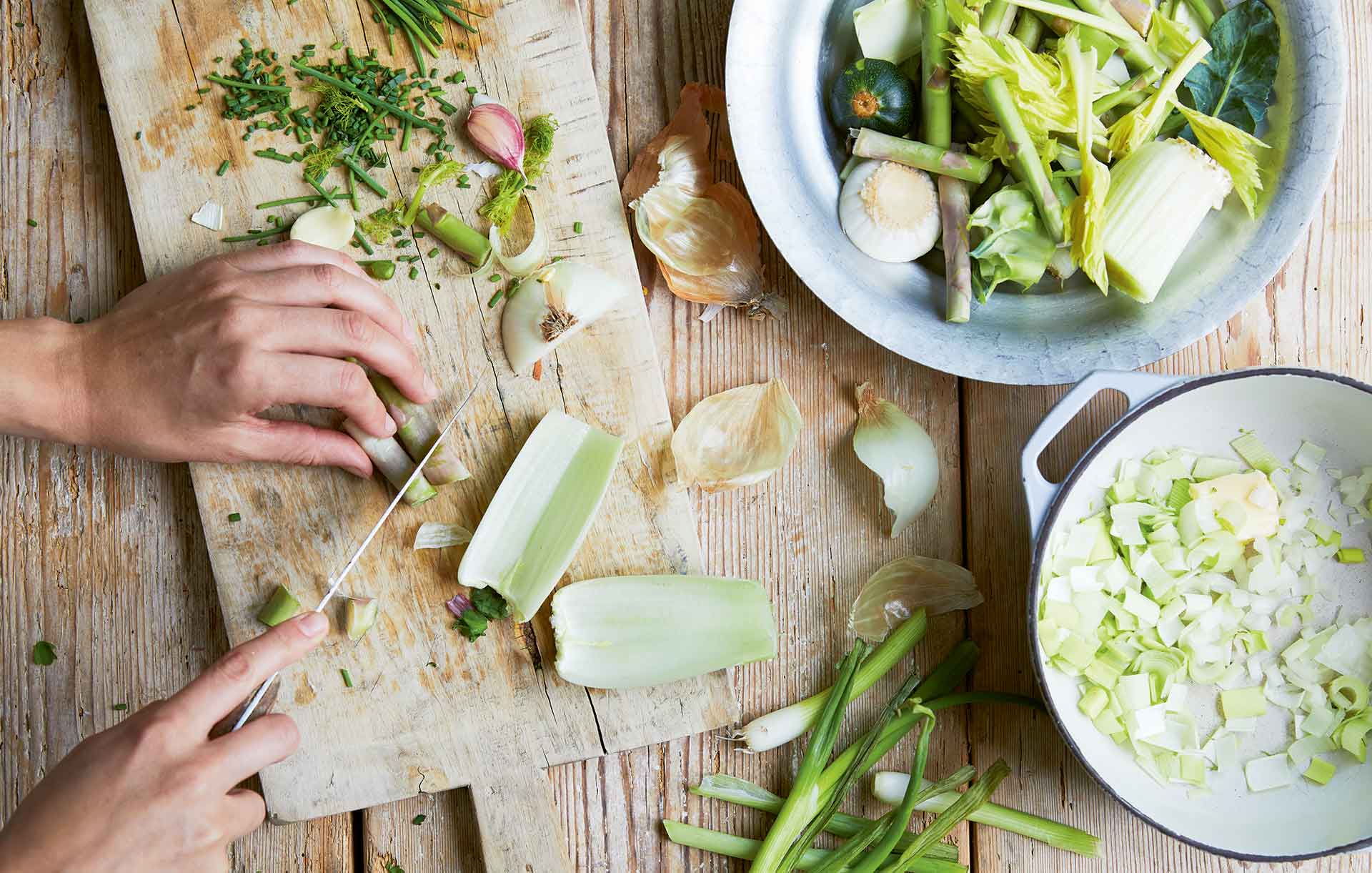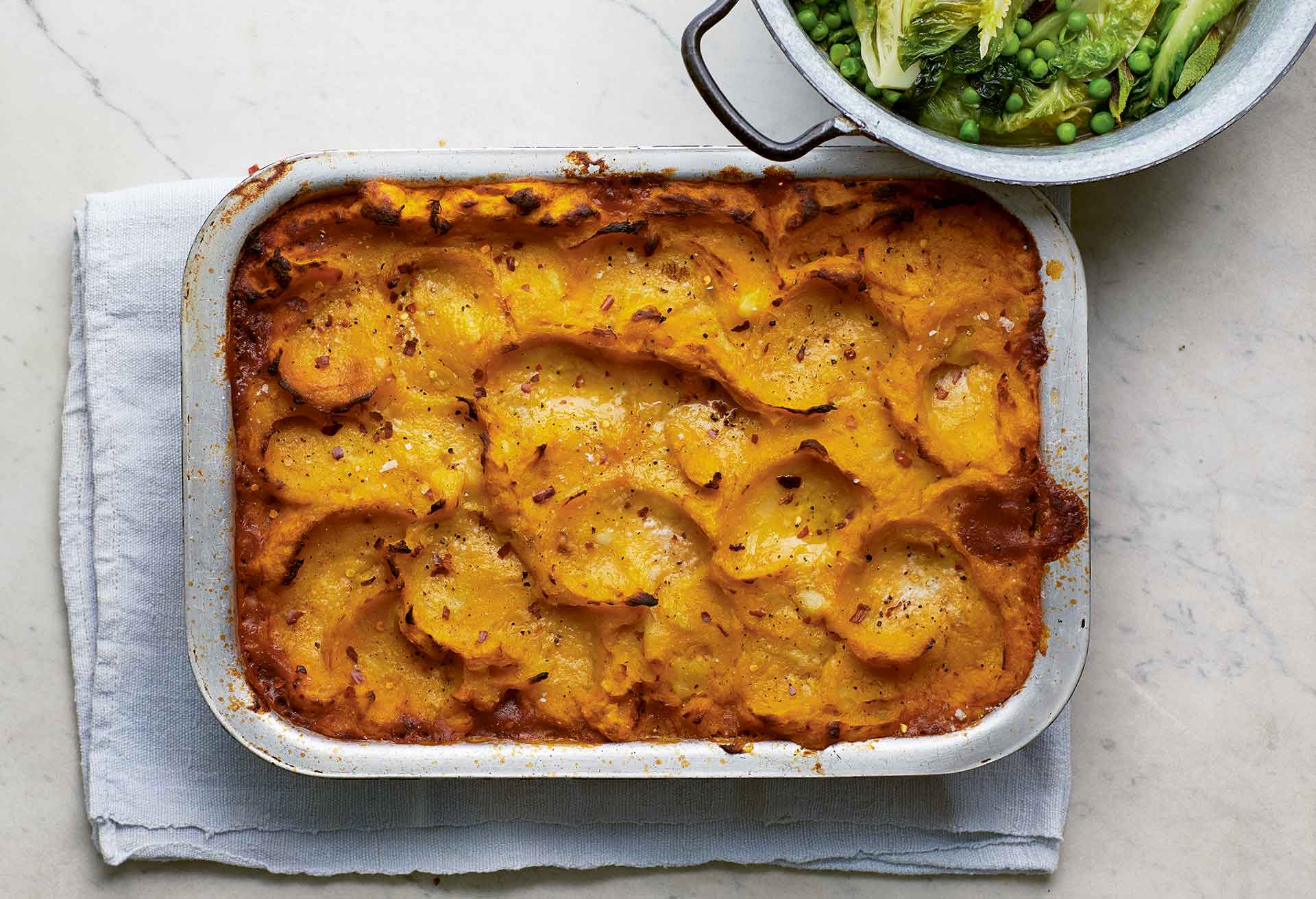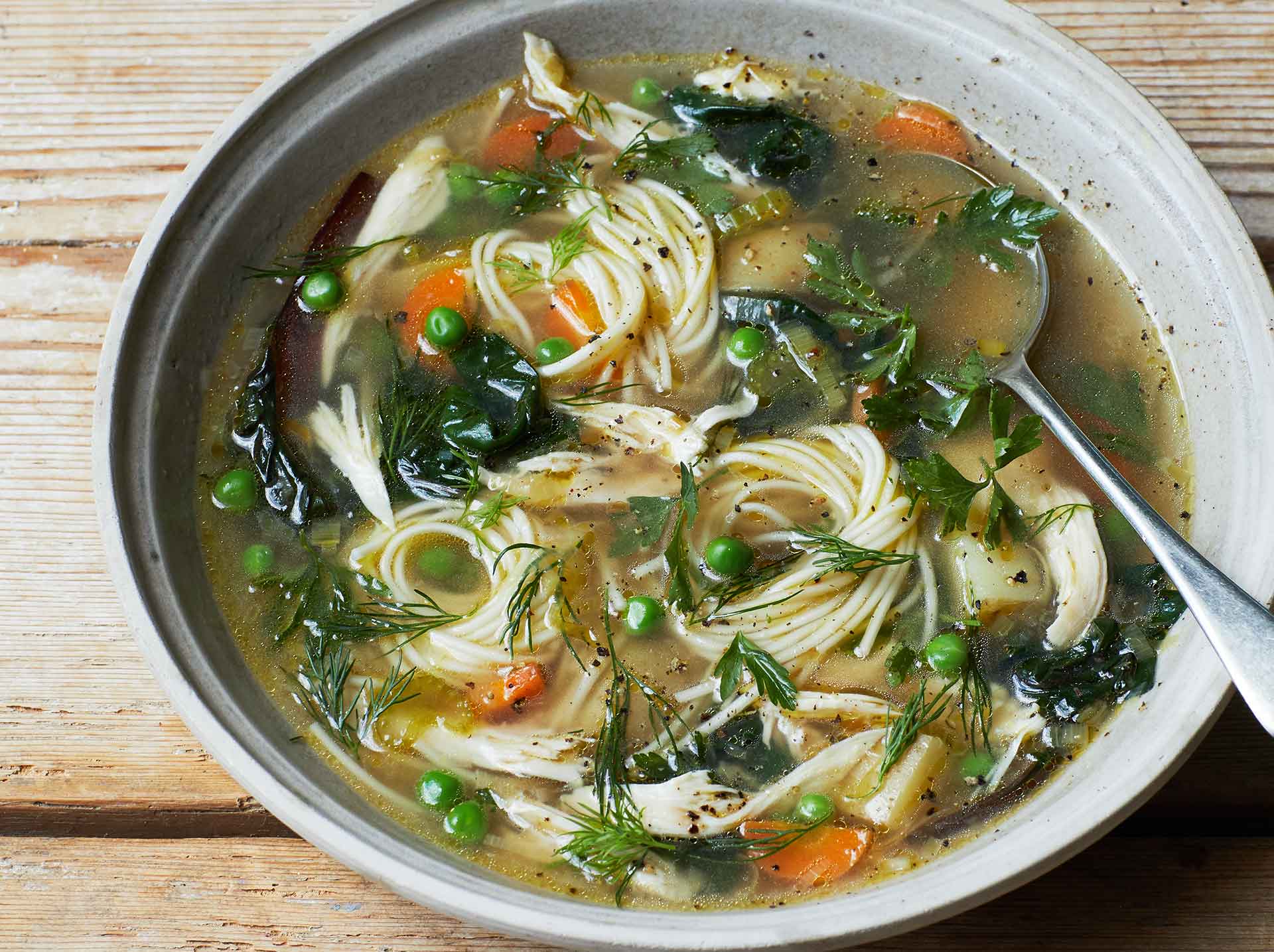5 Tips for Eco-Friendly Cooking from the New Flexitarian Cookbook “Eat Green”
As the issues of food waste and our food system’s impact on the environment gain more attention, we’re happy to see some of the mainstream media and well-known cookbook authors teaching their readers the importance of thoughtful shopping and eating. London’s Melissa Hemsley is one of the latest to guide her audience towards eco-friendly cooking, with her new cookbook of flexitarian recipes, “Eat Green.” London-based Hemsley started out as part of the sister duo Hemsley + Hemsley, a bonafide British culinary empire with cookbooks, a television show and a London café to boot. Hemsley started writing solo cookbooks in 2018 and the following April she launched a sustainable cooking column on Vogue.co.uk and shifted her cooking and recipes towards environmental themes. Picture Giadia De Laurentiis talking about food waste and climate change. Sounds good, right?
With “Eat Green,” published January 2020, Hemsley focuses on flexitarian recipes — she’s an omnivore herself — as well as reducing food waste — to promote more eco-friendly cooking. The cookbook is first and foremost approachable: “I wanted to write a book of easy and delicious recipes that advocates a more environmentally friendly way of cooking and eating, but also a book that recognizes that for some people and their families, cutting out dairy, fish and meat is unsustainable or unrealistic.” She achieves this with 100 recipes, most of which are vegetarian, and all of which have ideas for seasonal swaps, waste-reducing tips and time-saving tricks.
While there certainly is more to be said about cooking and eating sustainably — we’d like to have seen Hemsley touch more on purchasing sustainable meat and seafood, as well as the importance of supporting regenerative farming practices — the book is a good resource for cutting back on food waste with a flexible cooking approach. And the more cookbooks that approach time in the kitchen and focus their lens on reducing waste and reducing meat consumption, the better. Here are five eco-friendly cooking takeaways we found most helpful from the book.
Start with One Habit
Hemsley admits she’s not perfect, and doesn’t demand her readers be either. “I am far from perfectly sustainable or self-sufficient – that would be impossible for most of us — but I try a little every day to be that bit more responsible for my impact,” she writes in the book’s intro. Instead of creating restrictive recipes and demanding guidelines, Hemsley’s flexitarian approachability makes her eco-friendly cooking suggestions doable. To get started, she suggests adopting one habit a week. This week try using up food scraps like stalks or stems; next week, buy unpackaged, in-season produce; choose something else the following week, perhaps cooking in bulk. By starting with one habit, she explains, and we agree, you slowly develop a general practice of wasting less, shopping smarter and eating more sustainably. (For a step-by-step to building these types of habits, try out our 28-day Reduce Your Foodprint challenge.)
Focus on What You Waste Most
Feedback from her readers showed Hemsley what the 13 most bought and thrown away fruits and vegetables are. To help reduce this waste, she focused the “Eat Green” recipes on these items, including carrots and their tops; herbs and their stems; tomatoes and peppers; and cauliflowers and leaves. In her buckwheat crepe recipe, she uses arugula as a filling because readers mentioned this was an item they often found rotting in the back of the fridge. Her recipe for chermoula cauliflower steaks gives an eco-friendly cooking take on cauliflower, roasting the cauliflower leaves and stalks alongside the cauliflower steaks. In another recipe, she gives a tip for those extra tomatoes, recommending midnight tomatoes, one of her favorite Nigella Lawson recipes: place halved cherry tomatoes on a sheet tray in a hot, switched off, oven overnight to dry out.
Of course, every shopping list and kitchen are different, and yours might differ from Hemsley’s readers. Spend a week or two looking at what you buy — and what you throw away — and focus on recipes that match those items.

Root to Stem, but Everything
Root to stem cooking is nothing new, but Hemsley applies that thinking to everything. Her recipes call for whole broccoli and cauliflower heads, stems, leaves and all. She turns the odds and ends of the cheese drawer into a creamy root vegetable gratin, and extra herbs and nuts into pesto. And when there’s a pile of stems and bottoms lying around, she makes bottoms soup — a quick simmer of herbaceous vegetables like leek and fennel that she turns into dinner with a soft-boiled egg and dollop of yogurt.
And at the end of the book, Hemsley also gives an A-to-Z guide for how to use all the most-thrown odds and ends. One of our favorite tips: saving squash peels from the compost bin by drying them out in a low oven into vegetable chips. As we’ve found time and time again in our own food waste-reducing recipes, this use-every-bit-of-everything mentality is the key to truly mastering eco-friendly cooking.

Raid Your Fridge
The main focus of “Eat Green” is to use all of your food up, with recipes like “Fridge-Raid Frittata” and “Clear-out-the-Fridge Curry.” By showcasing dishes that can be a blank canvas to use nearly any ingredient — like frittata and curry — Hemsley gives a structured recipe to those who need it, and freedom to those willing to toss whatever they’ve got into the frying pan. Her shepherd’s pie — made with lentils rather than the traditional meat base — calls for a combination of whatever root vegetables you have for the mashed topping. In other recipes, the ingredient list is equally flexible; rather than specifying, she calls for a strong cheese, like Cheddar in one, and a handful of seeds or nuts in the other. She’s written the recipes with enough information to prepare them correctly, but — unlike so many restrictive recipes requiring tiny amounts of numerous ingredients, contributing to waste — she allows the home cook to adjust with what they have in the kitchen, helping them to reframe their thinking and reduce food waste.
Eco-Friendly Cooking is Flexible Cooking
Hemsley also stresses flexibility when shopping. Rather than sticking to exactly what’s in the recipe or on your shopping list, adjust to what is available at the market. “Be inspired by the seasons — fruit and veg are more affordable when they’re in season plus they taste better,” she writes.
To help readers make that adjustment, many of the recipes include tips for other ingredients that can be substitutes based on seasonality or flavor preferences. Her “flexi-swaps” help guide readers through the flexitarian recipes, suggesting where meat can be added in if desired, or taken out of the few recipes that include it. She recommends replacing meat with shiitake or oyster mushrooms; root vegetables like parsnips can easily be swapped out and replaced by other root vegetables like carrots, sweet potatoes or squash; and a winter stew can be made in spring by using zucchini instead of root vegetables, and peas instead of leafy greens. In the book’s first chapter, she briefly points out the importance of purchasing the best quality and responsibly-sourced meat and dairy possible, another key element of eco-friendly cooking. “It does make it more expensive,” she writes,” but I afford it by choosing to eat less of it.”
Her rescue noodle soup, which can be found below, is a combination of it all. A recipe Hemsley loves making to use leftover roast meats, you can make it using vegetable scraps, leftover roasted vegetables or frozen veg — whatever you’ve got. It uses any type of noodles, a mix of leafy greens — stems included — and whatever fresh herbs you have. And if you prefer a vegetarian version, she recommends adding mushrooms and a pinch of dried seaweed or miso for a boost of extra flavor. Plus, it’s extremely easy to make — in just 30 minutes — showing that eco-friendly cooking and reducing food waste can be fast and approachable.

Rescue Noodle Soup with Leftover Chicken
Melissa Hemsley, “Eat Green”
Serves 4
Time: 30 minutes
There’s nothing quite like a warming bowl of homemade soup to make you feel a thousand times better. If I’ve had a Sunday roast chicken, I make this on a Monday to get a great boost of vegetables in. It’s based on store cupboard and freezer ingredients like frozen peas, onion, garlic and carrots, though you could swap in anything that needs using up. You can up the amount of vegetables or noodles here, so adjust to your liking. Post-Christmas and other celebrations, this is a fantastic way to use up leftover turkey or any other leftover meats.
Ingredients
1 tbsp ghee or butter
1 large leek or onion, diced
3 garlic cloves, finely chopped
1.2 litres vegetable stock or bone broth
1 big handful of a mix of fresh herbs, like parsley and dill, leaves and stems chopped
1 tbsp fresh thyme leaves or 1 tsp dried
1 bay leaf, dried or fresh
2 celery sticks, diced
2 carrots, thinly sliced
2 handfuls of 2cm chunks of root veg like sweet potato, squash, pumpkin, potato or (in the summer) courgette
400g noodles or spaghetti, any type
1 tsp olive oil
300g mix of cabbage, rainbow chard and/or chard, stems finely chopped and leaves shredded
300g leftover shredded chicken
Juice of ¼ lemon or 1 tsp apple cider vinegar
2 big handfuls of frozen peas or sweetcorn
Sea salt and black pepper
(See Flexi Swap tip for optional extras)
Method
In a large wide saucepan, heat the ghee or butter and fry the leek or onion over a medium heat for 8 minutes while you prep everything else. Add the garlic and fry for another minute.
Add the stock or broth, chopped parsley or dill stems, thyme, bay leaf, celery, carrot, root veg and some salt and pepper, pop the lid on and cook for 15 minutes until the carrot is almost tender.
Meanwhile, cook the noodles in a separate pan until almost tender (check the label for suggested timings), then drain and rinse under cold water to stop them cooking further. Toss with the olive oil to stop them clumping and set aside.
Back to your soup pan: add the chopped cabbage and chard stems, shredded chicken, lemon juice or vinegar and cook for a few more minutes.
Add the chard leaves, frozen peas or sweetcorn and cooked noodles for a final 2 minutes so that the chard wilts, the peas cook and the noodles heat through. Season to taste and serve up straight away, topped with the fresh herb leaves.
Additional Notes
Waste Not
You don’t have to use noodles here, you can add any pasta shapes you like so just use whatever odds and ends of pasta packets you have. You could even add the pasta straight into the soup to cook and save on using a second pan.
Flexi Swap
For a vegetarian version, swap the chicken for 500g roughly chopped mushrooms and a pinch of dried seaweed or seaweed salt. Sometimes I add even more garlic and a thumb of grated ginger plus 1 tsp ground turmeric for an extra boost. Try adding a tablespoon of miso or tamari just before serving or swap the herbs for coriander and mint.
EXTRACTED FROM EAT GREEN BY MELISSA HEMSLEY (EBURY PRESS, £22) Photography by Philippa Langley
More Reading
The ins and outs of vegan hot dogs
April 16, 2024
7 books about onions, garlic and the wide world of alliums
March 13, 2024
Eat seasonally this winter with persimmons
January 18, 2024
Commit to sustainable habits with our Reduce Your Foodprint Challenge
December 18, 2023
9 homemade preserves to gift (or keep) this holiday season
December 12, 2023
Get creative with these food preservation methods
December 1, 2023
Meatless Monday: The first 20 years
November 1, 2023
Why 2023 is the International Year of Millets
October 5, 2023
Eat more grains — and keep it local
September 29, 2023
When it comes to sustainable spices, 'single-origin' isn’t everything
September 8, 2023

